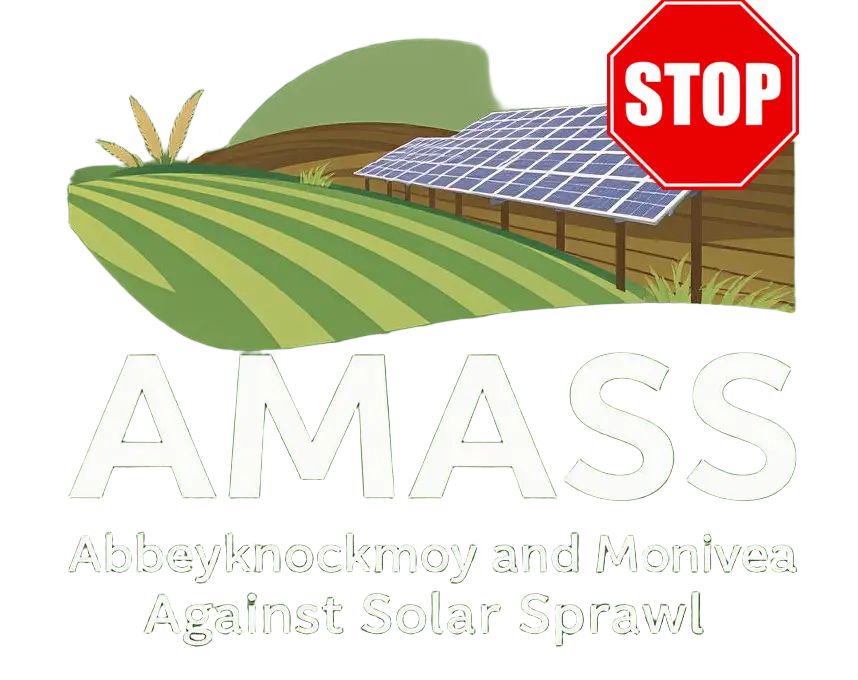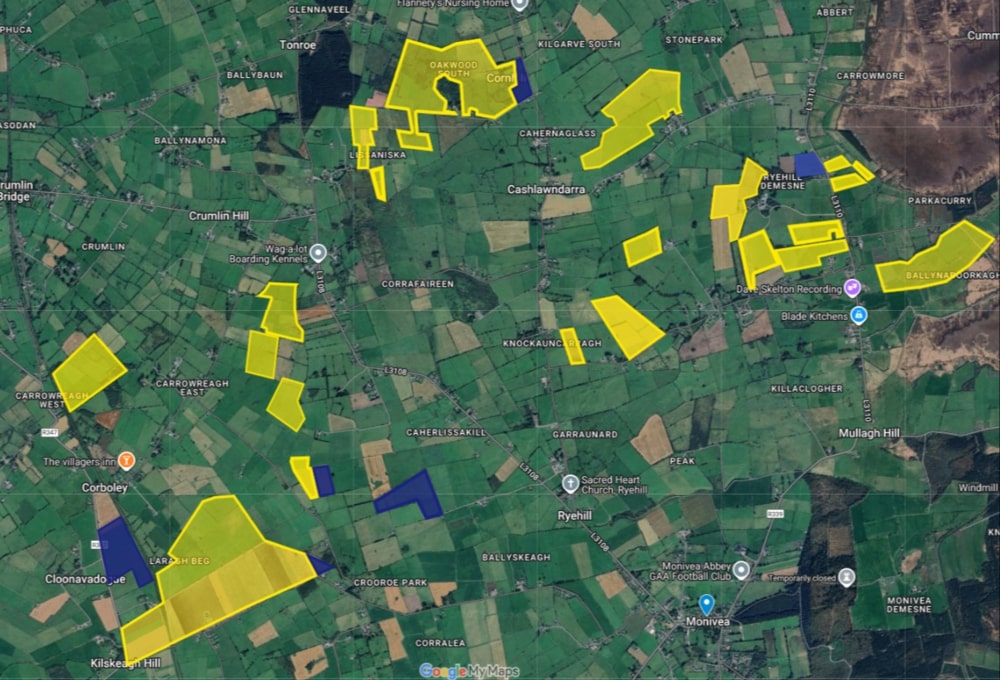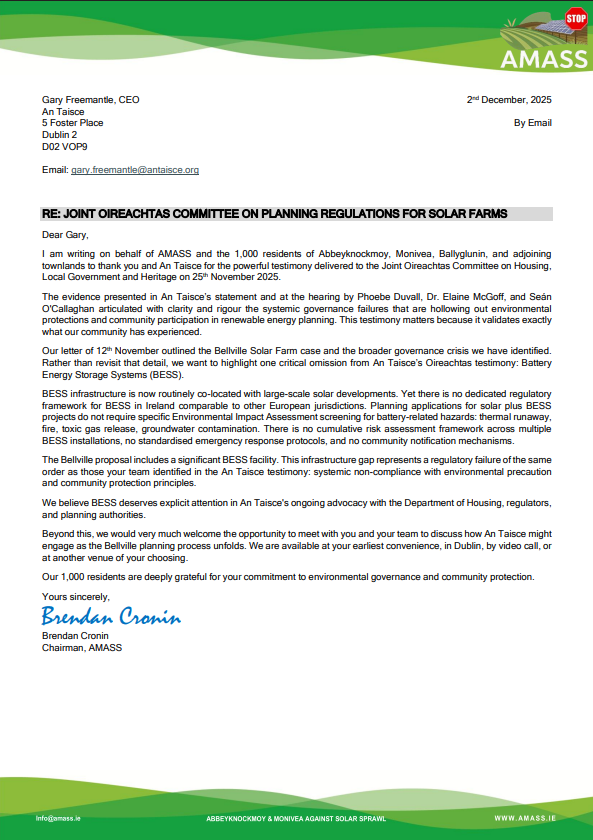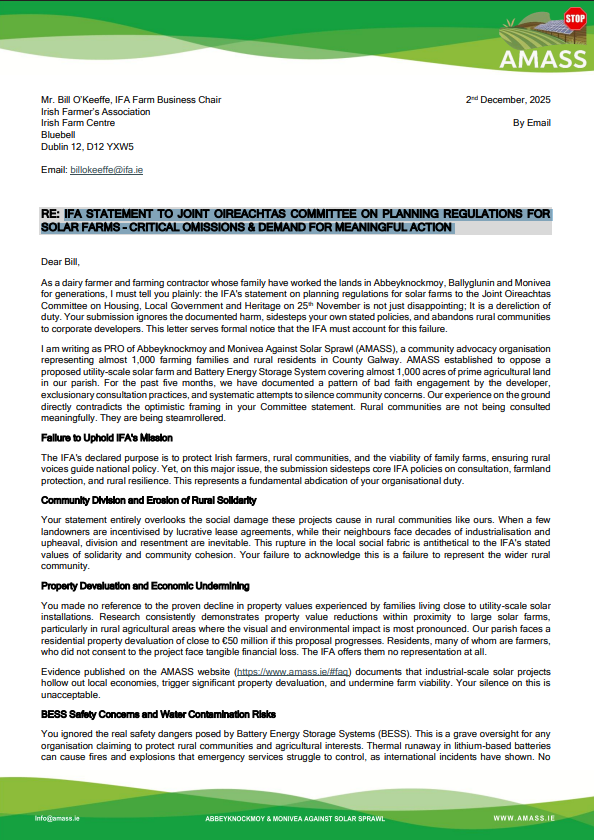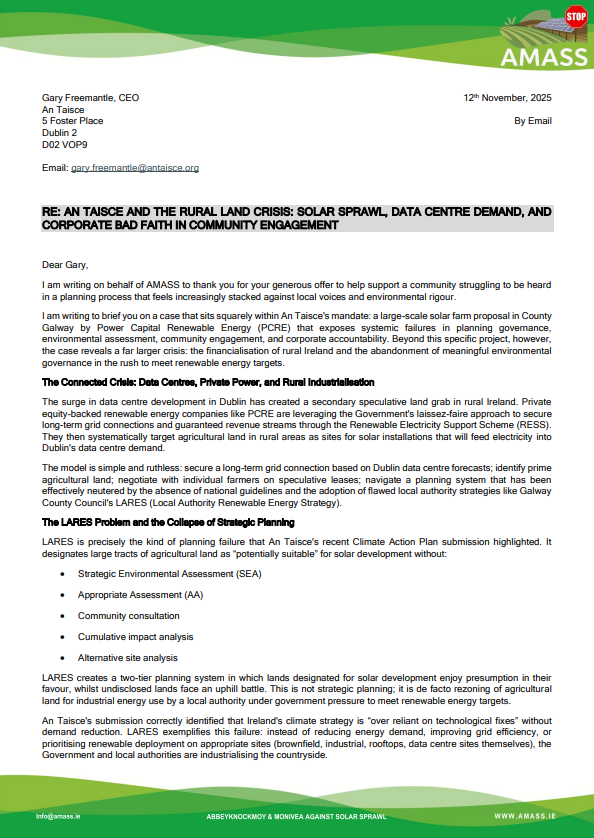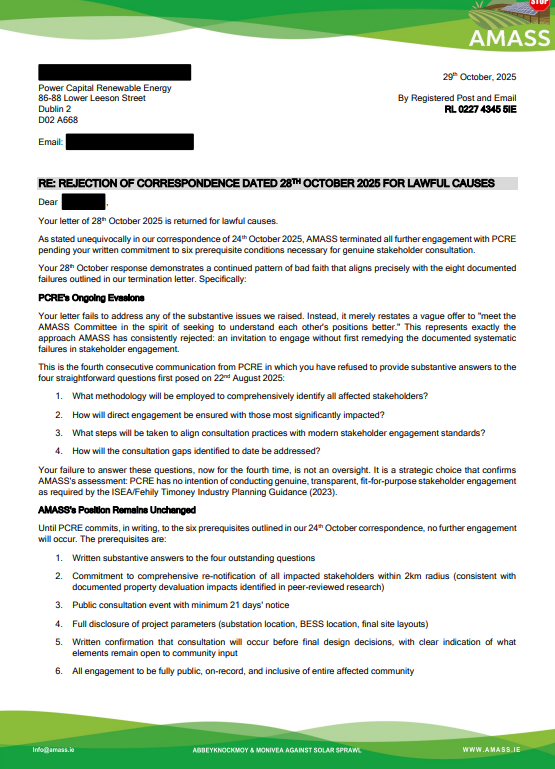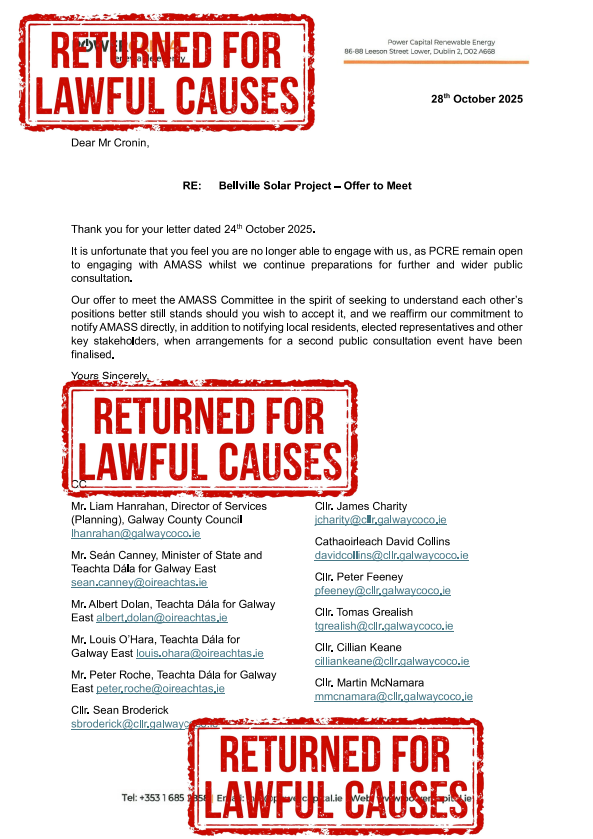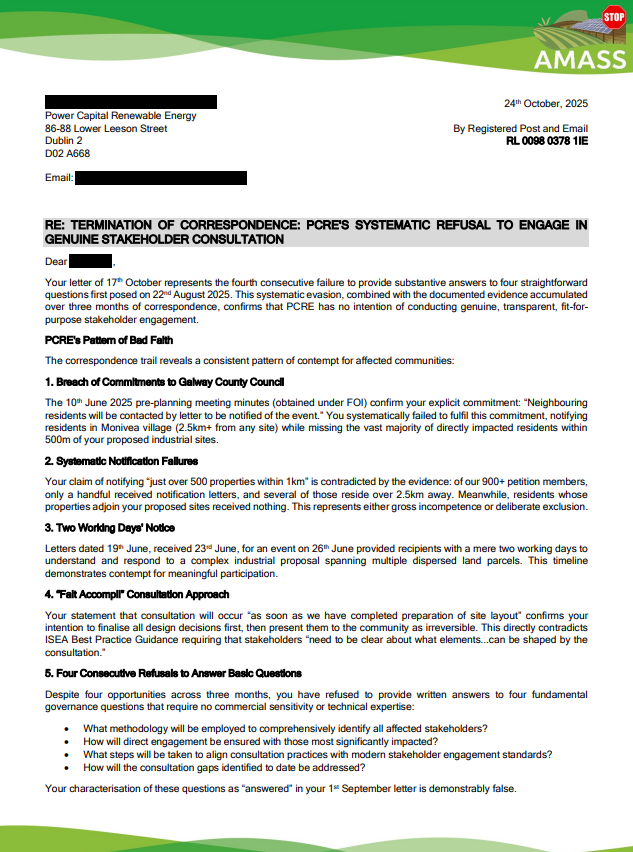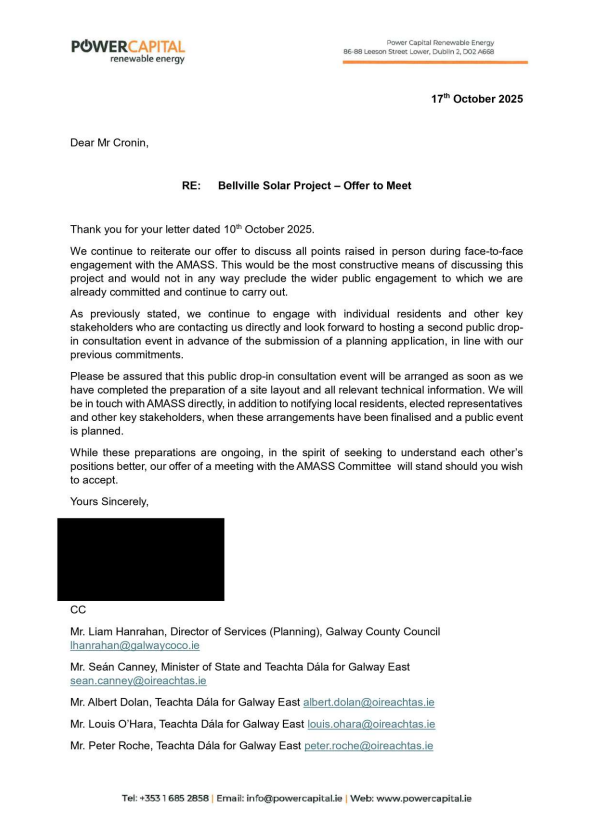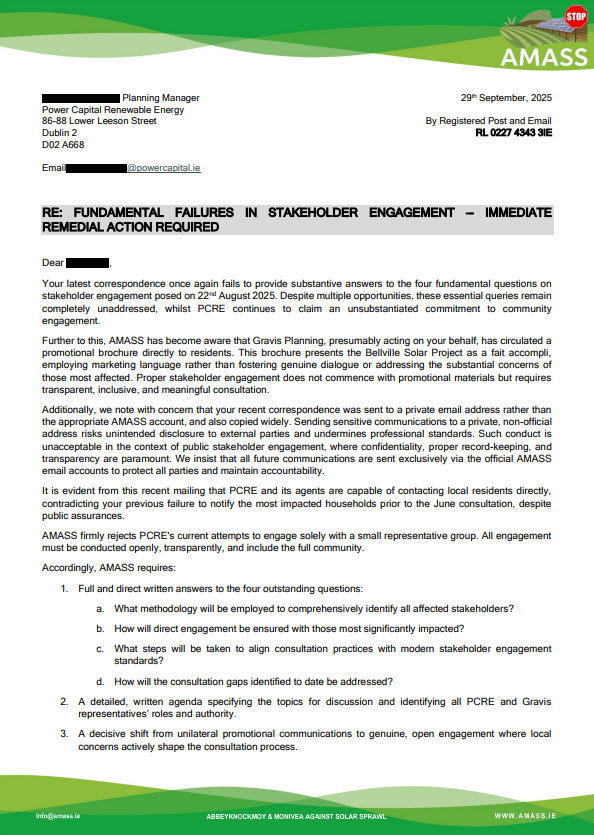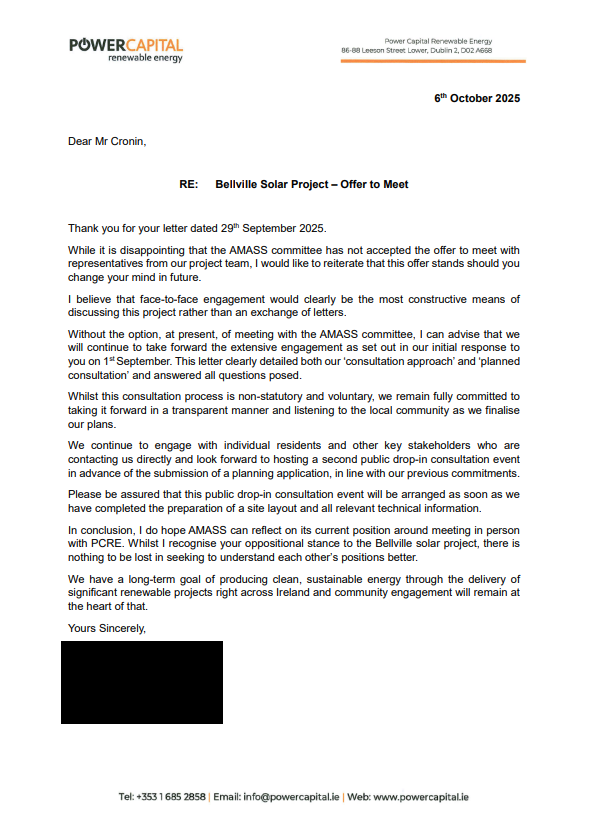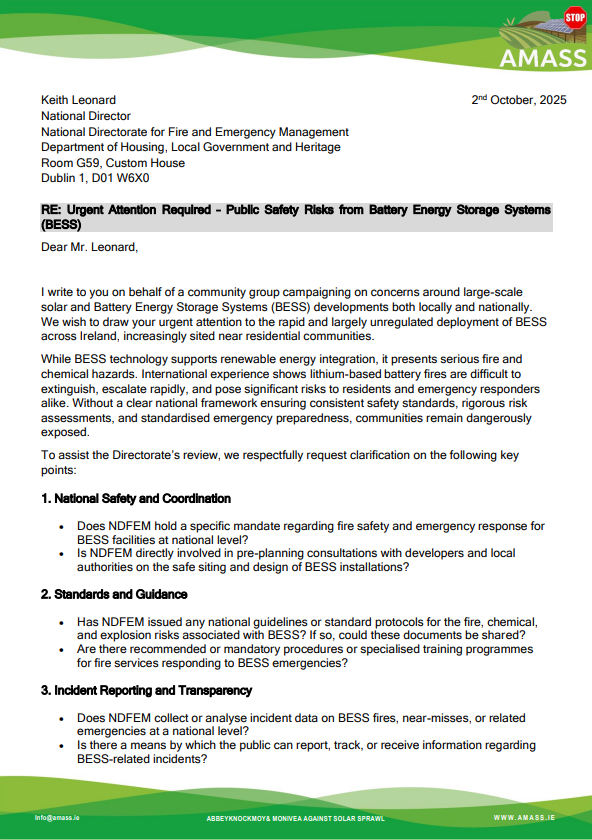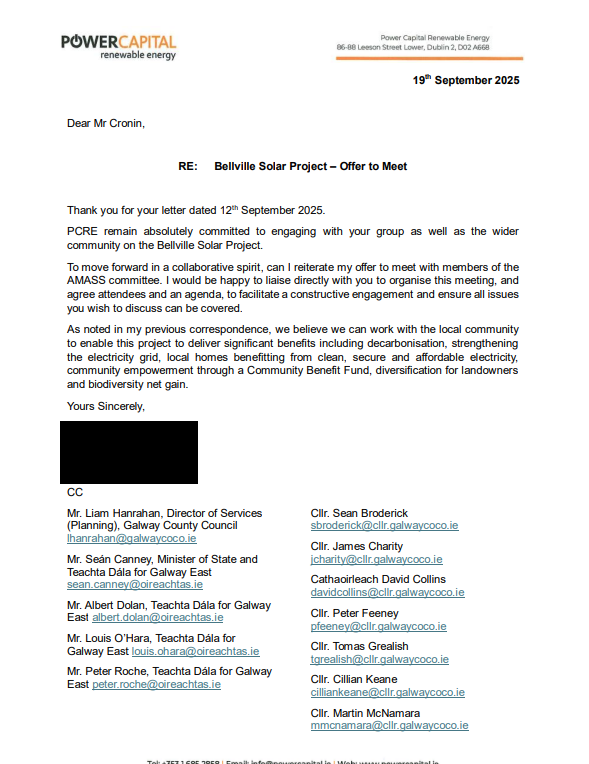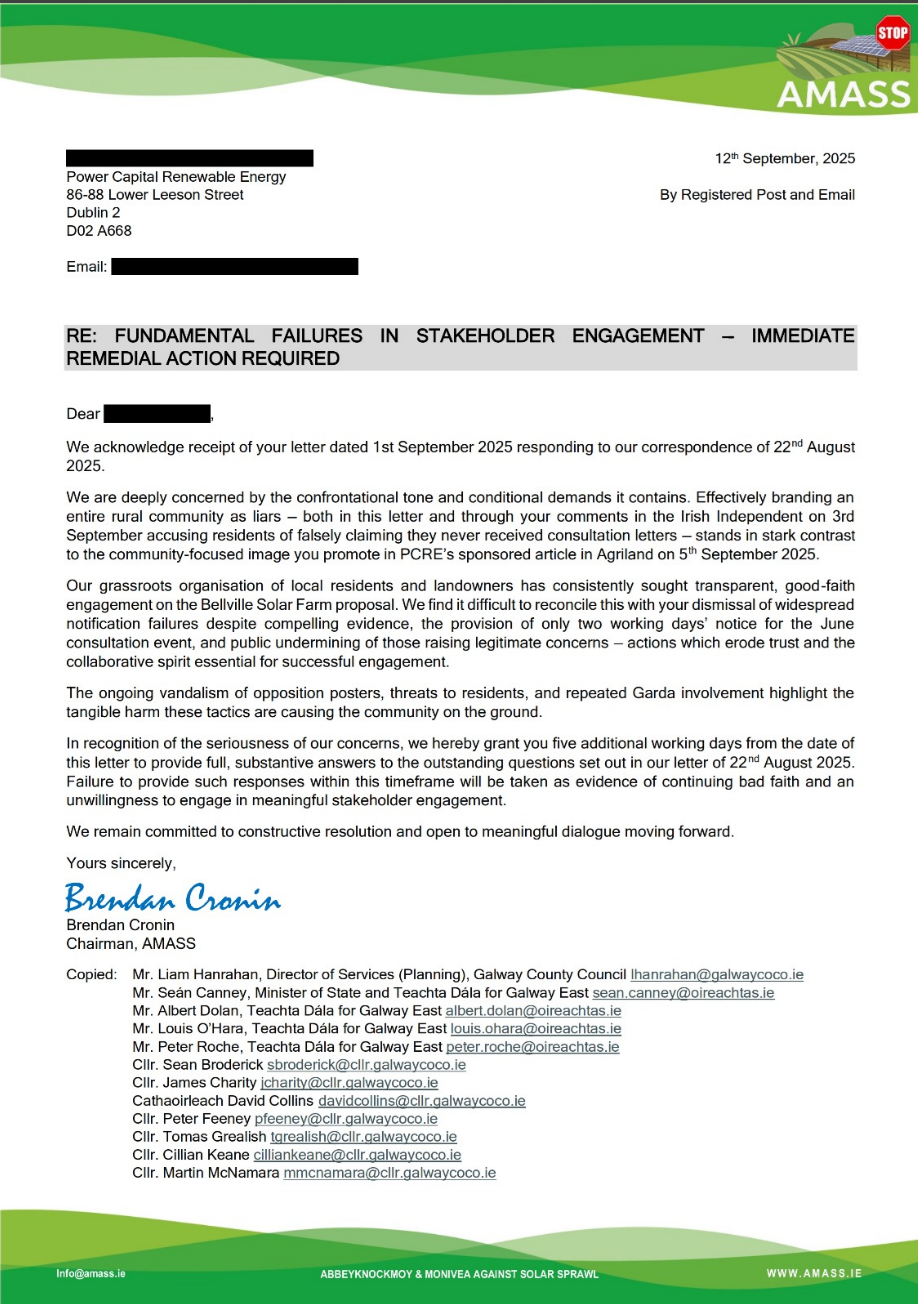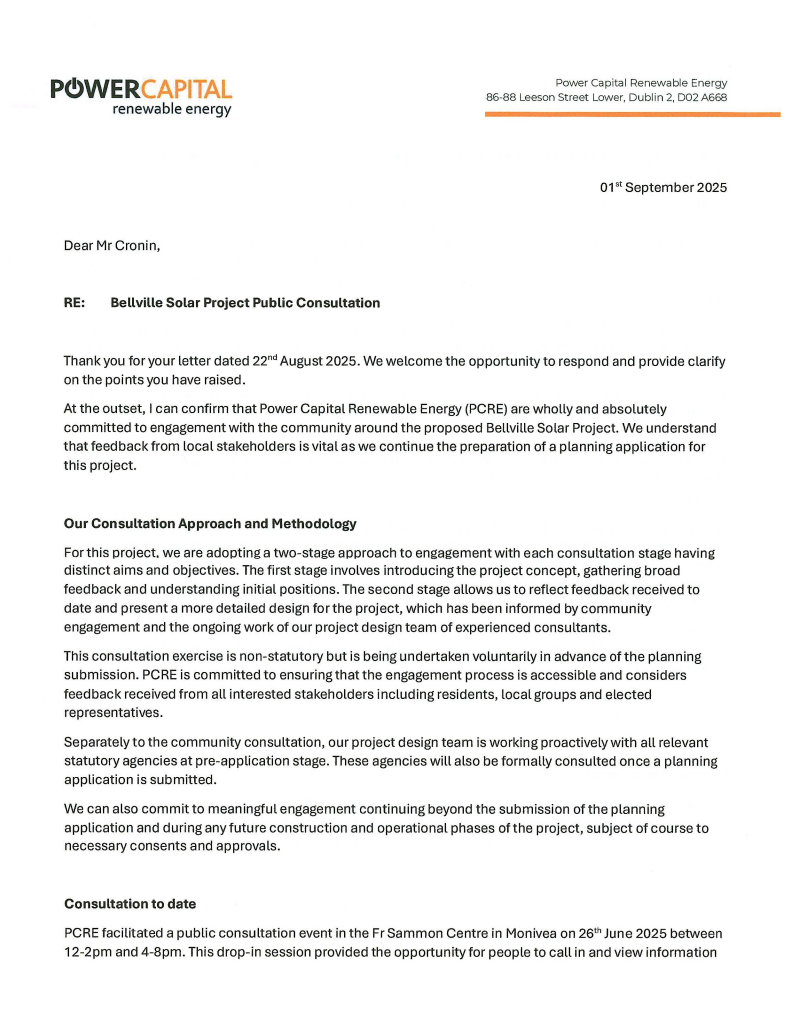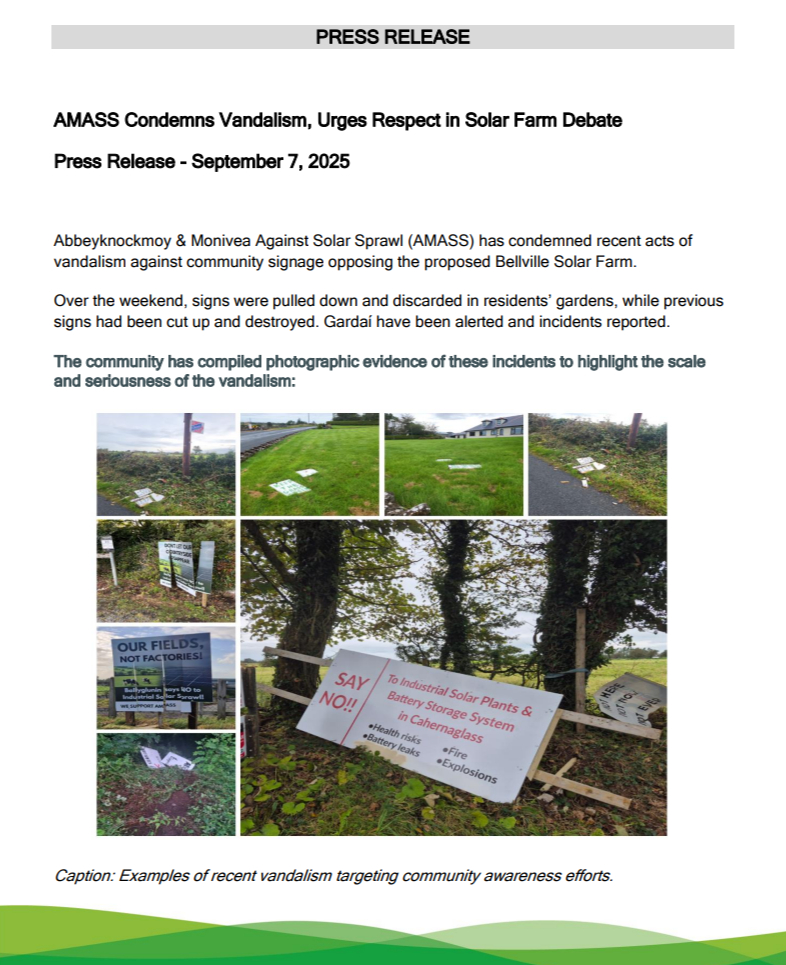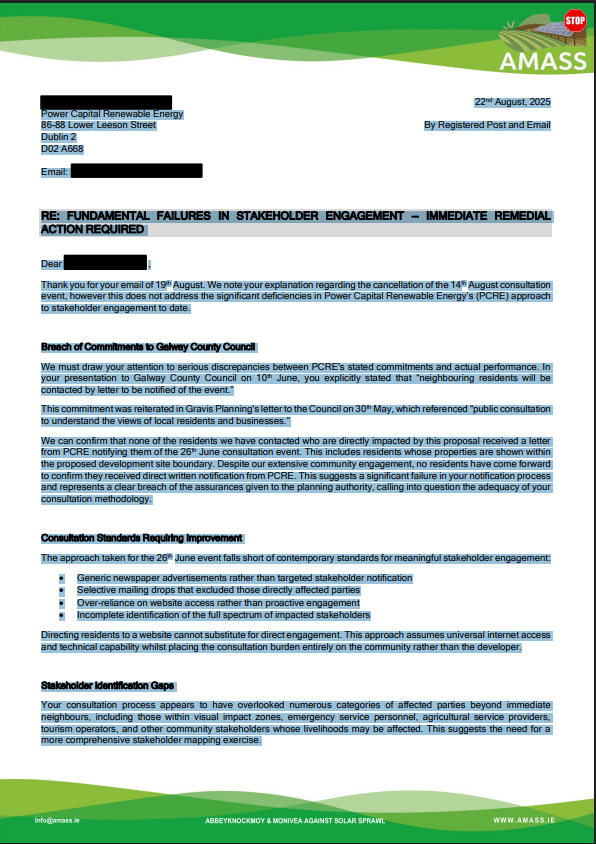Who We Are
We are local farmers, families and residents of Monivea & Abbeyknockmoy and the surrounding townlands united in our opposition to industrial-scale solar developments threatening prime agricultural land, natural habitats and our rural heritage.
Join Us
AMASS collaborates directly and supportively with the local and national communities of Ireland to reduce the increasing sprawl of Industrial Scale Solar Developments. We welcome groups and organisations whose work intersects with our mission and aligns with our values. We want to always to participate actively in efforts to facilitate the full protection of the food producing farmland across all our communities.If You Live in These Areas, This Affects You
The proposed Belville solar project is planned to cover approximately 1,000 acres within Abbeyknockmoy parish and its neighboring areas. Over 400 acres lie in the Laragh Beg / Ballyglunin area, where many residents are only now learning about the plans.
Initial Areas Impacted by Phase 1 Include:
- Laragh Beg
- Ballyskeagh
- Kilskeagh Hill
- Cloonavadogue
- Carrowreagh East
- Caherlissakill
- Lissaniska
- Oakwood South
- Farravaun
- Belleville
- Cahernaglass
- Carrowmore
- Cashlaundarragh
- Ryehill Demesne
- Parkacurry
- Ballynaboorkagh
- Knockauncarragh
- Monivea
Construction will bring months of heavy vehicle traffic on local rural roads, causing noise, road wear, and disruption. If you live in these areas or surrounding areas, this development directly affects your home, land, access routes, and quality of life.
Don’t let nearby residents remain unaware - please share this site and get involved today.
Why We're Taking a Stand
Our land is being targeted for speculative energy projects that do not serve the best interests of our community. These projects are profit-driven and risk undermining local food production, biodiversity and the rural way of life. We're not anti-renewables - we're pro-community, pro-farming and pro-common sense.
Food Before Energy
Prime food-producing land should not be converted into energy plantations. Sustainable farming must remain central to Abbeyknockmoy & Monivea's future.
Nature Under Threat
Solar sprawl risks fragmenting habitats, draining wetlands and damaging biodiversity. We must protect what makes this place special.
Community First
We want smart, local renewables that empower communities, not enrich absentee developers. Decisions must be made *with* us, not *to* us.
Development Zone Under Consideration
The map below shows the proposed development area. Shaded areas represent almost 1000 acres of land currently under consideration for industrial-scale solar development.
Recently excluded areas are shown in purple.
Can't load the interactive map? Open the map in a new tab .
Frequently Asked Questions
Clear, honest answers to the most common questions about the proposed solar development in Abbeyknockmoy & Monivea.
- What is the proposed development?
- The development is a large-scale industrial solar power plant planned for prime agricultural land in Abbeyknockmoy & Monivea, covering almost 1000 acres. This project threatens local food production, biodiversity and our rural heritage.
- Has the community been consulted?
- Many residents feel they've been excluded from decision-making processes. We demand transparent, inclusive consultations that respect local voices.
- I'm not a farmer - will this development affect me?
- Yes, and here's why: Large-scale solar power plants impact everyone in the area, not just the landowners leasing their fields. Potential effects include changes to local biodiversity, drainage patterns, and groundwater; increased heavy traffic during construction; and long-term visual and environmental changes. Even if you're not directly adjacent, these projects can affect property values, local infrastructure, and the character of the countryside you use and enjoy.
- Will the solar power plant affect house prices?
-
Research from multiple independent, peer-reviewed studies consistently shows that utility-scale solar farms have measurable negative impacts on nearby residential property values. The key factors driving this include visual intrusion, the industrialisation of rural landscapes, increased construction traffic during development, and concerns about environmental and land-use risks. These effects are most pronounced within approximately 0.8 to 1.6 kilometres (0.5 to 1 mile) of the site but can influence the broader area's desirability and market value.
Notable studies documenting these negative impacts include:
- Virginia Tech's 2025 analysis found homes within 3 miles of utility-scale solar farms experienced an average value decrease of 4.8%, with properties within 0.5 miles experiencing up to 7.2% reductions. This comprehensive study analysed 8.8 million property sales across 3,699 solar sites in 40 US states and was published in the Proceedings of the National Academy of Sciences. (link, PNAS paper)
- Lawrence Berkeley National Laboratory (LBNL) 2023 study by Elmallah et al. identified average price reductions of 1.5% for properties within 0.5 miles of utility-scale solar farms, based on 1.8 million home transactions across six US states. Properties within 0.25 miles experienced 2.3% declines. (link)
- University of Rhode Island research (Gaur and Lang, 2020) documented property value declines of 1.7% within 1 mile of utility-scale solar projects, with homes within 0.1 miles (528 feet) experiencing 7% declines. This study analysed over 400,000 housing transactions around 208 utility-scale solar installations in Massachusetts and Rhode Island. (link)
- Dutch study by Dröes and Koster (2021) found a 2.6% decrease in house prices within 1 kilometre of solar farms, based on comprehensive national housing market data from the Netherlands covering 1985-2019. (link)
- UK analysis for Botley West Solar Farm estimated immediate losses of £153 million across properties within 1.5km, with individual properties closest to the solar farm losing £40,475 (detached), £27,145 (semi-detached), and £24,467 (terraced houses). The study noted that "the closer to a utility solar farm and the larger the installation, the greater is the adverse impact on house values." (link)
- Wisconsin analysis (2025) found homes within 0.5 miles of large-scale solar farms experienced 7.2% value reductions, with homes within 3 miles experiencing 4.8% reductions. Effects were negligible beyond 3 miles. (link)
The evidence consistently demonstrates that utility-scale solar developments create significant negative impacts on nearby residential property values, with effects most pronounced within the immediate vicinity and gradually diminishing with distance. The impacts are particularly severe in rural areas where solar installations alter the open space and rural character that contribute to property desirability.
For landowners, homebuyers, and policymakers, it is crucial to consider this robust evidence showing that utility-scale solar developments can negatively impact nearby residential property values. The industrialisation of rural landscapes and associated project effects affect not only homes directly adjacent to solar sites but often the wider community and market perception.
- What impact will construction have on local residents and roads?
-
Construction will cause significant disruption in the local area, lasting several months. Temporary road closures and detours will affect daily travel, and existing utilities such as water and electricity may be interrupted or damaged. Local authorities have limited budgets, increasing the risk that roads may be poorly reinstated or remain in worse condition after works.
Heavy vehicles will increase traffic volumes, accelerating road wear and structural damage beyond the site boundaries, raising safety risks for motorists, pedestrians, and cyclists.
Due to shallow rock layers, drilling will likely be required to secure solar panel supports, causing considerable noise disturbance. Construction activity can also disturb local livestock, especially during sensitive periods like lambing and calving.
- Why oppose solar power plants? Aren't renewables good?
- Renewable energy is vital - but not at the cost of our best farmland and ecosystems. Industrial-scale solar power plants on productive land undermine food security and damage habitats. We support smart, community-based renewables that respect local needs.
- Isn’t this solar power plant helping fight climate change?
- Renewable energy is essential in reducing carbon emissions and combating climate change. However, developing large-scale solar power plants on prime agricultural land sacrifices food security, biodiversity, and the character of rural communities. Ireland has many alternative options-such as rooftop solar, brownfield sites, and smaller community-owned projects-that can provide clean energy without damaging vital farmland and ecosystems. We support renewable energy, but it must be done responsibly, respecting local needs and long-term sustainability.
- How will this affect local farmers and food supply?
- Removing nearly 1000 acres from food production threatens livelihoods and reduces local food availability. This land supports diverse crops and livestock essential to our economy and heritage.
- What alternatives do you propose?
- We advocate for renewable solutions that prioritize community control, use less productive land and protect biodiversity. Rooftop solar, brownfield sites and smaller distributed generation can meet energy needs without sacrificing prime farmland.
- Will covering farmland with solar panels harm bees and other pollinators?
- Yes. A study of 20 French solar installations found that pollinator numbers dropped by 76% under the panels, and plant-pollinator interactions declined by 86% compared to unshaded areas. Solar panels remove vegetation, reduce forage, and alter the microclimate, making the land largely inhospitable for pollinators.
Reference: Lec'hvien et al., 2025. - Do electromagnetic fields (EMFs) from solar installations affect pollinators?
- Yes. Research shows that EMFs disrupt bee navigation, foraging, and communication. This can lead to bees failing to return to the hive and ultimately impair colony health.
Reference: Molina-Montenegro et al., 2023. - How drastic is the overall impact on pollinators in solar installations?
- Severe. Most shaded areas under panels become unsuitable for pollinators, causing sharp reductions in pollinator populations and disrupting local plant-pollinator networks.
Reference: Lec'hvien et al., 2025. - Will the solar power plant create noise?
- While solar panels themselves are silent, industrial solar power plants include inverters, transformers, and cooling fans that generate a low hum. During construction, expect heavy machinery noise, increased traffic, and general disruption. Even after completion, the constant background noise from equipment can carry in quiet rural areas, especially at night.
- Can sheep realistically graze under or near the solar panels?
- In large-scale industrial solar power plants, grazing is severely limited. The panels cast shade that reduces grass growth and quality, while soil compaction and maintenance activities further degrade pasture. Stocking rates under panels drop dramatically compared to normal pasture-often to less than one sheep per two acres, if grazing is allowed at all. Additionally, fencing and restricted access prevent normal animal movement. Industrial solar power plants are not a substitute for productive farmland.
- Are these projects permanent? Can the land be restored afterward?
- Industrial solar power plants often involve heavy infrastructure with uncertain restoration outcomes. Soil compaction, chemical use and habitat loss can cause long-term damage, making true restoration difficult.
- What happens to the land after the solar power plant’s lease ends?
-
Industrial solar power plants are generally developed under long-term leases lasting around 35 years; these agreements typically cover the entire lifecycle of the project, including construction, operation, decommissioning, and land restoration. Although developers often commit to restoring the land to its original condition at the end of the lease, there is currently little to no long-term evidence demonstrating the effectiveness of such restoration efforts.
The installation and operation of solar farms can cause significant impacts, including soil compaction from heavy machinery, the presence of substantial infrastructure, and the potential use of chemicals, all of which may harm soil quality and local ecosystems. The processes involved in restoring land after solar farm operations cease are complex, expensive, and inherently uncertain, particularly where robust regulatory oversight and legally binding guarantees are lacking.
In addition, there is growing uncertainty within the solar energy sector. Recent developments, such as the potential cancellation of subsidies in major markets like the United States, underline the risk that financial and policy support for solar projects may diminish. If similar trends occur in Europe, projects such as the Bellville solar farm could face premature abandonment, increasing the risk that sites are left unused or inadequately remediated.
Given the significant risks outlined, the future of the land after the solar power plant’s lease ends is a serious concern that demands immediate and ongoing scrutiny. Without strong, enforceable restoration guarantees and strict oversight, there is a real danger the land will remain degraded and unusable for farming or wildlife. This issue cannot be overlooked by anyone with a stake in the land’s long-term health and value.
- How tall will the solar panels and structures be? Will they affect the local scenery?
- Solar panels and supporting infrastructure typically stand between 1.5 to 3 meters high but can include taller mounting racks, transformers, and security fencing that further disrupt sightlines. When spread over hundreds of acres, these installations create an industrial landscape that contrasts sharply with traditional rural views, altering the character and enjoyment of the countryside for residents and visitors alike. The visual impact can be long-lasting and difficult to mitigate.
- Will the solar power plant affect local heritage or monuments?
- The proposed development covers areas rich in cultural heritage and may be near protected monuments. Large-scale industrial installations can disturb archaeological sites, damage landscapes of historical significance, and diminish the cultural character of the area. We insist on thorough heritage impact assessments and full protection of all monuments and historical landmarks during planning and development.
- Will the solar power plant be fenced off? What about security?
- Yes. Industrial solar power plants are typically surrounded by high-security fencing and CCTV, creating an industrial zone where there was once open countryside. This not only changes the character of the area but can also restrict wildlife movement and fragment habitats. Security lighting and surveillance can further disturb nocturnal species and alter the rural environment.
- Will the solar power plant have nighttime lighting?
- Yes. For security reasons, solar power plants are often equipped with floodlights and motion-activated lighting. This artificial lighting can disrupt local wildlife, especially nocturnal species, and alter the natural night environment. It can also affect residents by increasing light pollution and disturbing sleep patterns.
- Are solar power plants dangerous?
- Solar power plants may seem harmless, but they operate with high-voltage systems that can kill instantly if mishandled. Fires involving solar panels are particularly hazardous: burning panels release toxic fumes and contaminated runoff that can pollute soil and water. Standard firefighting methods do not work effectively, and emergency services need specialist training and equipment to respond safely. Without this, lives and the environment are at risk.
- Can a solar power plant fire be extinguished?
- Not easily. Solar arrays continue generating electricity even when disconnected, meaning parts of the system remain live and dangerous. Firefighters face electrocution hazards and toxic smoke, often forcing them to let fires burn under controlled conditions. Suppression requires pre-planned strategies, isolation procedures and specialist gear, none of which are guaranteed at every rural site. The scale and complexity of solar fires can make them logistically challenging and prolonged.
- What are the risks associated with Battery Energy Storage Systems (BESS)?
-
BESS sites store enormous amounts of energy in lithium-ion batteries, including Lithium Iron Phosphate (LiFePO4) types which are proposed for Bellville. While LiFePO4 batteries are sometimes described as safer or “non-combustible,” this is misleading and false as they can and do catch fire under certain conditions such as damage, overheating or defects. When a battery thermal event occurs, it can lead to "thermal runaway" - a self-sustaining chain reaction causing violent fires, explosions, and the release of highly toxic gases like hydrogen fluoride, carbon monoxide, and hydrogen cyanide.
These fires:
- Burn at extreme temperatures, often between 700°C and 1,000°C, and are nearly impossible to extinguish with standard firefighting methods
- Emit dense toxic smoke and contaminated water runoff, posing serious threats to people, livestock, and the environment
- Can reignite unpredictably days after initial suppression attempts
- Frequently result in road closures, resident evacuations, and long-term site contamination requiring extensive remediation
These risks are well documented internationally and must not be underestimated when siting BESS near homes or agricultural land.
- How are BESS fires different from other industrial fires?
- BESS fires are significantly more dangerous than typical industrial incidents due to their nature and scale:
- they generate extreme heat and produce thick, poisonous smoke laden with hazardous gases
- explosions can occur internally within battery cells, propagating rapidly from one cell to another (thermal runaway)
- common firefighting agents like water and foam have limited effectiveness and efforts often shift to containment rather than extinguishing
- fire crews typically must allow controlled burns while maintaining evacuation zones for days or longer for public safety
- extreme contamination of air, soil and water is frequent, with cleanup and ecosystem recovery processes lasting many months
These complexities demand specialised emergency plans and resources that may not be fully in place at every rural BESS site.
- Do Battery Energy Storage Systems (BESS) create noise?
- Yes. BESS facilities run cooling fans, inverters, and transformers around the clock, generating a continuous low-frequency hum. In quiet rural areas, this noise travels and becomes especially intrusive at night, disturbing residents who live nearby.
- Do Battery Energy Storage Systems (BESS) emit electromagnetic fields (EMF)?
- Yes. High-voltage components in BESS facilities generate electromagnetic fields similar to those near power substations. Levels drop with distance, but because energy is concentrated in one location, exposure close to the perimeter can be significant. While industry claims these levels are "safe," long-term health effects remain uncertain and public concern is justified.
- What about evacuation zones for BESS fires?
Veterinary expert Hugh Dillon, a partner at Troytown Equine Hospital, has highlighted the serious safety concerns associated with large BESS fires. He cites a 2025 incident at a 300MW lithium-ion battery storage fire in California where authorities ordered evacuation of an area covering 20 square kilometres. This example underscores the immense hazard posed by BESS fires due to toxic smoke, risk of explosion and extensive firefighting challenges that can endanger humans and livestock alike. Currently, Ireland has no dedicated safety regulator specifically overseeing lithium-ion battery installations, including those using Lithium Iron Phosphate technology, which raises concerns about emergency preparedness and the feasibility of such extensive evacuations.
For context, a 20 square kilometre area is shown via the red circle in the image below. It would stretch from Crumlin to Ryehill and from Abbeyknockmoy to Caherlissakill.
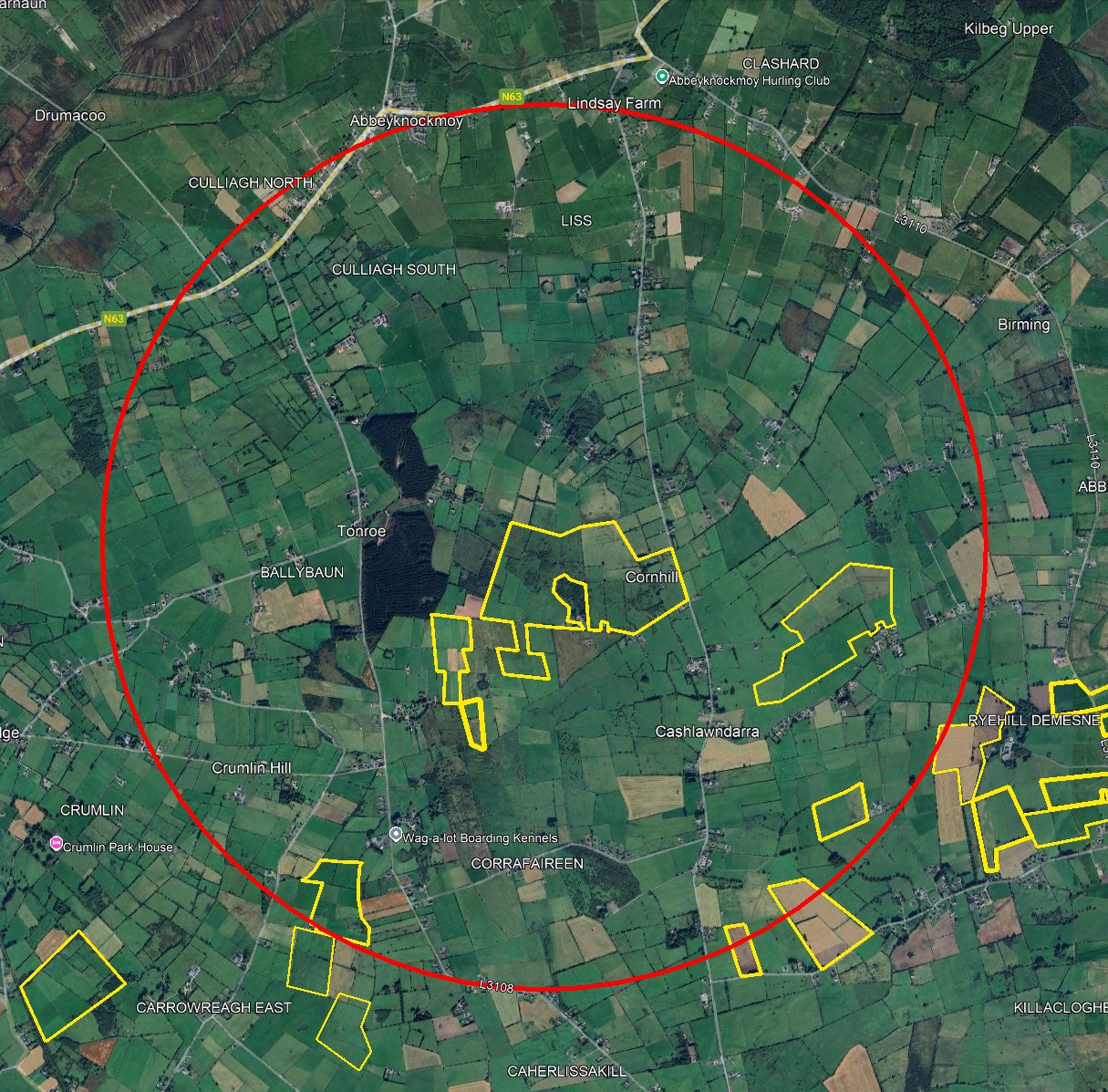
Reference: The Irish Field, “Bloodstock industry warned of threat from solar battery projects” (March 2025) - https://www.theirishfield.ie/bloodstock/news/bloodstock-industry-warned-of-threat-from-solar-battery-projects-860273
- How can I get involved or support the campaign?
- Get involved by signing petitions, attending local meetings, and spreading the word in your community. Every action helps protect our farmland and heritage.
Support the Petition
Abbeyknockmoy & Monivea says NO to industrial solar. Every voice matters.
972
Signatures
Last updated: Nov 30, 2025
Important: Please note that any funds donated via Change.org
do not reach our campaign.
Thank you for standing with us and supporting our fight.
Please check your spam or junk folder if you don't see the confirmation email in your inbox. Thank you!
Media & Resources
Stay informed with local media on our campaign against solar sprawl.

Concerns over major Galway solar farm project as public consultation process delayed
Concerns have been raised around the controversial Bellville Solar Farm in Galway, with one local TD highlighting a number of issue on the public consultation process so far.
Read More
Local TD Blasts Developers Over Lack of Community Consultation on Monivea Solar Farm
Galway East TD Albert Dolan has publicly criticised the proposers of the Belleville solar farm
Read More
Galway County Council Refuses FOI Request on Ireland’s Largest Solar Farm
Galway County Council has refused an FOI request regarding plans for Ireland’s largest solar farm, citing concerns over transparency and governance.
Read More
Council Refuses FOI Request on Monivea Solar Farm Project
Galway County Council has refused to release pre-planning records on the 900-acre Monivea solar farm, citing commercial sensitivity.
Read More
Plans to Build Ireland’s Largest Solar Farm in Galway Sparks Local Opposition
Residents in a Galway townland have expressed concerns about a proposed solar farm expected to be Ireland’s largest, highlighting local opposition.
Read More
Major solar projects a "Trojan horse" to the dairy industry - Cork TD
The Fianna Fáil deputy was discussing solar panel projects on Irish farmland with former Green Party leader Eamon Ryan on Today with Claire Byrne.
Read More
Locals ‘spooked' over Ireland's biggest solar power plant
LOCAL residents in a North Galway village have been ‘spooked' by recently revealed proposals to build the biggest ever solar power plant in the country covering an area of between 700 and 900 acres.
Read More
Galway Talks
~23:10 - We hear the latest after a Public meeting was held in Monivea over solar power plant development

Proposed Monivea Solar Power Plant Described as Disaster at Council Meeting
Local council meeting criticizes Monivea solar power plant plans, calling it a “disaster” with strong community opposition.
Read More
Public meeting in Monivea over solar power plant development
A public meeting will take place in Monivea this evening over plans for a large scale solar power plant in the area.
Read MoreSupport Our Crowdfunder
Help us fight for transparency and protect our community. Every donation, big or small, strengthens our case against the proposed solar development in Abbeyknockmoy & Monivea.
Correspondence
Read correspondence issued by AMASS to authorities, stakeholders & Media regarding Bellville Solar Farm developments.
AMASS Highlights BESS Regulatory Gaps in Solar Planning
2 December 2025
AMASS thanks An Taisce for their Oireachtas testimony on solar farm governance while stressing a critical omission: the lack of dedicated regulation for Battery Energy Storage Systems (BESS). The letter calls attention to cumulative risk, emergency response gaps, and community notification failings, urging An Taisce to explicitly advocate for robust oversight of solar plus BESS developments in Ireland.
View LetterAMASS Challenges IFA Over Solar Farm Policy Failures
2 December 2025
AMASS issues a formal notice to the Irish Farmers’ Association, condemning its Joint Oireachtas Committee submission for ignoring farmland loss, community division, property devaluation, and the severe safety risks posed by BESS facilities. The letter demands statutory consultation, protection of prime farmland, robust national BESS regulation, and a full reassessment of Ireland’s solar targets in light of data centre–driven land pressures.
View LetterAMASS Warns An Taisce of Solar Sprawl & Planning Failures
12 November 2025
AMASS briefs An Taisce’s CEO on the systemic governance failures exposed by PCRE’s Bellville Solar Farm proposal. The letter details the collapse of proper planning under Galway’s LARES framework, the national crisis of uncontrolled solar sprawl driven by data-centre demand, and the absence of BESS risk regulation. It invites partnership on planning observations, public statements, and strategic intervention to restore environmental accountability.
View LetterAMASS Formally Rejects PCRE’s Pattern of Bad Faith
29 October 2025
AMASS returns PCRE’s latest letter “for lawful causes,” citing continued bad faith and failure to address four core stakeholder engagement questions first raised in August. The response reiterates six binding prerequisites for any future dialogue and places PCRE on formal notice that further evasive or non-substantive correspondence will be treated as vexatious and forwarded to planning authorities as evidence of procedural misconduct.
View LetterPCRE’s Continuing Pattern of Bad Faith
28 October 2025
Instead of addressing AMASS’s formal termination of correspondence and documented concerns, PCRE sidesteps the substance entirely. Confirms they have zero interest in meaningful engagement, instead focusing on tokenism and box-ticking. This letter has been returned for lawful causes..
View LetterAMASS Terminates Correspondence
24 October 2025
AMASS formally ends engagement with PCRE after three months of evasive correspondence. The letter accuses PCRE of systematic bad faith, breach of ISEA guidance, and contempt for affected residents, citing failures in notification, archaeological heritage protection, and transparency.
View LetterPCRE Dismissive Response
17 October 2025
PCRE's shortest, most dismissive response. Simply reiterates offer to meet and promises a second public event “as soon as we have completed preparation of site layout,” continuing to frame consultation as conditional on AMASS accepting private meetings.
View LetterAMASS holds PCRE to account for engagement failures
10 October 2025
AMASS criticises PCRE for patronising the community, refusing to answer basic stakeholder questions, providing inconsistent project information, breaching ISEA best practice guidance, and failing to protect archaeological heritage. The group demands fully public, transparent, and on-the-record consultation before any further engagement.
View LetterPCRE doesn't want to meet community
06 October 2025
PCRE continues to dodge the simple questions and doesn't want to meet with the full community. The letter repeats an offer to meet AMASS committee but provides no real answers, showing its engagement is largely PR-focused.
View LetterAMASS Letter on BESS Safety
02 October 2025
AMASS raises urgent concerns regarding the rapid deployment of Battery Energy Storage Systems (BESS) near residential areas. The letter requests clarity on national safety standards, emergency preparedness, incident reporting, and community protection. It highlights serious fire and chemical hazards and urges NDFEM to ensure robust safety measures and public awareness.
View LetterAMASS Response to PCRE
29 September 2025
This letter formally rejects PCRE's failure to engage meaningfully with the full community. AMASS highlights the circulation of promotional materials without consultation, the improper use of private email addresses, and the need for full transparency. It demands substantive answers to four critical stakeholder engagement questions within seven days, along with confirmation of fully public, inclusive engagement.
View LetterPCRE continues to dodge the simple questions
19 September 2025
PCRE continues to dodge the simple questions AMASS has repeatedly raised. Despite claiming commitment to engage with the community, the letter offers only a meeting and highlights project benefits, without addressing the key stakeholder concerns. This shows that PCRE’s supposed engagement is largely PR-focused rather than substantive.
View LetterLetter to Power Capital Renewable Energy
12 September 2025
AMASS expresses deep concern over the dismissive tone and conditional demands in PCRE’s letter, highlighting failures in meaningful consultation, notification, and community impact. The reply demands comprehensive answers within five working days and stresses the serious harm caused by PCRE’s approach to local engagement.
View LetterLetter from PCRE
1 September 2025
Power Capital Renewable Energy’s letter attempts to portray its community consultation as thorough and meaningful, but it underplays significant failures acknowledged by local residents and elected representatives. The letter adopts a confrontational tone, demanding the withdrawal of criticisms and effectively branding the community as dishonest. It fails to address genuine concerns over poor notification, limited consultation notice, and growing social tensions caused by the Bellville Solar Farm proposal.
View LetterPress Release Vandalism of Signs
7 September 2025
AMASS issued a press release condemning vandalism of community signage opposing the proposed Bellville Solar Farm and reaffirming the group's commitment to a respectful, fact-based campaign.
View Press ReleaseLetter to Minister O'Brien
23 August 2025
AMASS wrote to Minister O'Brien highlighting serious safety concerns about the proposed Bellville Solar Farm, urging immediate review and regulatory oversight.
View LetterLetter to Power Capital Renewable Energy
22 August 2025
AMASS issued a formal letter to PCRE highlighting fundamental failures in their stakeholder engagement process for the proposed Bellville Solar Farm. The letter demands immediate remedial action and a transparent consultation process before any planning application proceeds.
View LetterKey Facts
Concrete figures about what's at stake in Abbeyknockmoy & Monivea.
Contact Us
Have questions or want to get involved? Send us a message and we'll get back to you soon.
Stand with Abbeyknockmoy & Monivea
Join the growing movement to protect our land, our livelihoods and our future.
